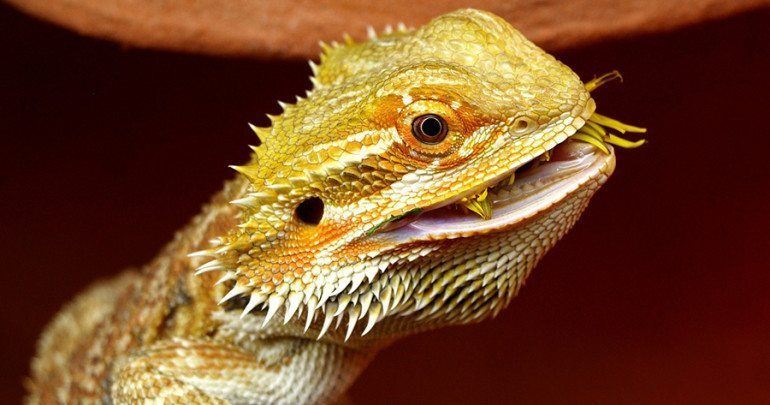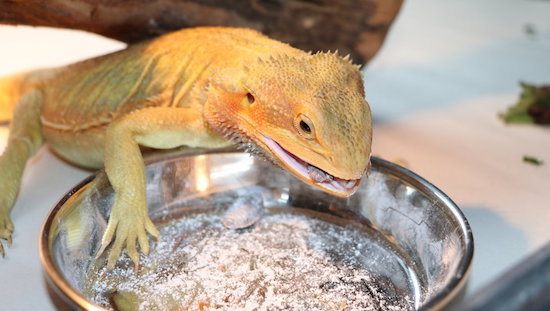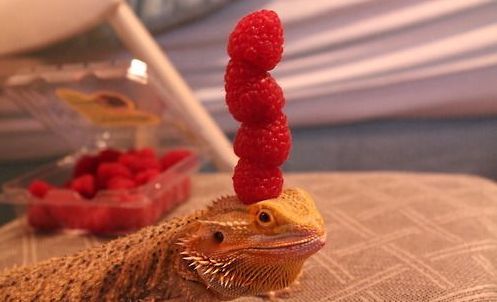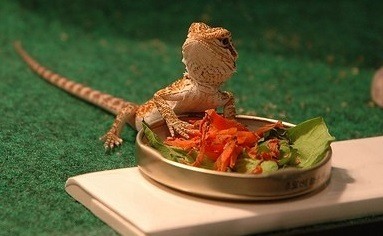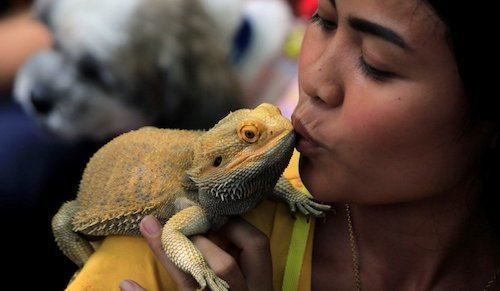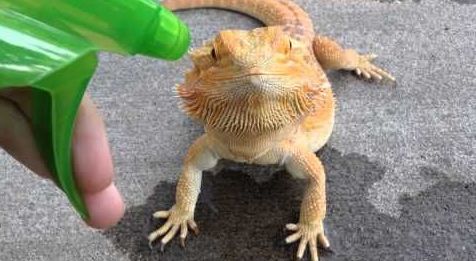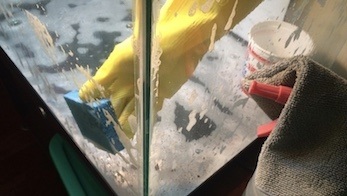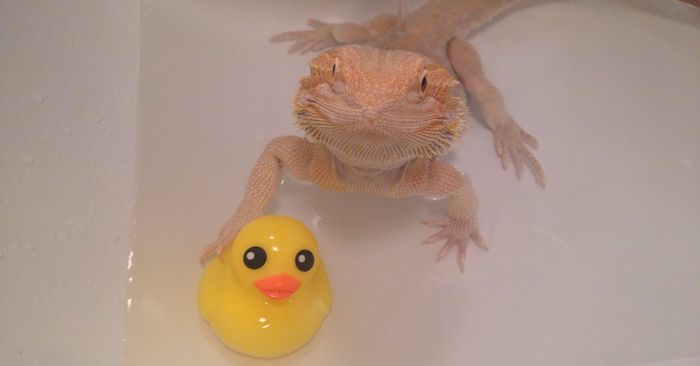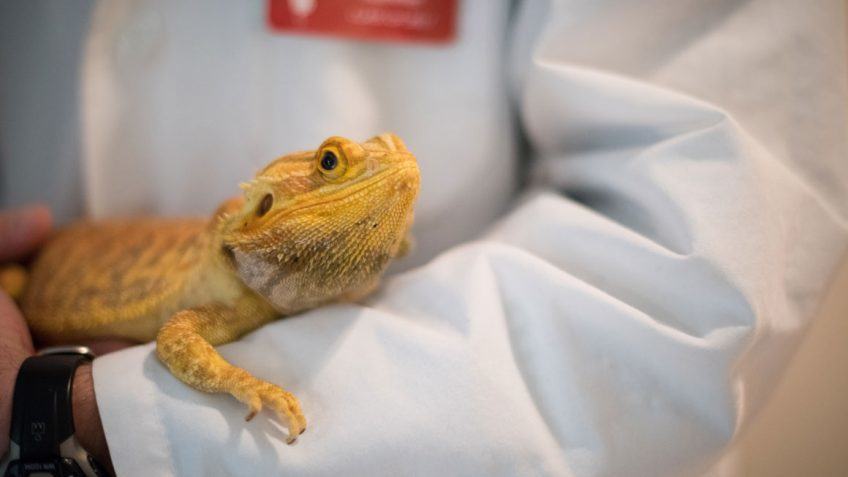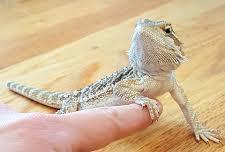If you’ve never owned a bearded dragon before, chances are you have plenty of questions about how to best care for them. I mean, it’s only natural that you would right?
Considering that bearded dragons only started becoming popular as pets within the last ten years or less, it’s not exactly like general society has loads of experience with them.
As such, I found it very important to put this article together to hopefully provide clarity on some of the more common questions.
So, with that being said just keep reading to uncover the answers to some very commonly asked questions!
In This Article
Bearded Dragon Diet Related Questions
Do you have to feed your bearded dragon every day?
While you don’t have to feed your bearded dragon every day… you absolutely should!
This is especially important if your dragon is under a year old, as in this particular instance, they should be eating 3 to 5 times a day to ensure they grow up healthy.
Now, if you skip a day or two with an adult dragon (who otherwise eats well) then they’ll be fine, albeit hungry. But adult bearded dragons should consume greens every day and insects at least every other day.
If you are feeding your bearded dragon every day and they’re not eating, then assume something is wrong, such as…
- They’re being a picky eater because you’re not giving them what they want.
- Their appetite is suppressed from an upcoming or ongoing shed.
- They’re brumating or are about to start.
- They’re sick (there should be other signs of this)
So, as you can see… your dragon wants to eat every day, but sometimes there are logical reasons why they don’t.
If you can assume your dragon isn’t eating because of reason #1, I recommend playing around with different staple foods.
For instance, maybe try Dubia roaches instead of crickets (or vice versa) OR swap out dandelion greens for squash and collard greens, etc.
Bearded dragons can develop their own personal taste preferences so sometimes it just take a little exploring to figure out what your beardie prefers.
What fruits can bearded dragons eat?
Although you shouldn’t give your bearded dragon fruit every day, you can definitely indulge them occasionally (as in once or twice a week max) with the following fruits…
- Apples (peeled)
- Apricot
- Blackberries
- Blueberries
- Cantaloupe
- Cherries
- Cranberries
- Figs
- Grapes (red & green)
- Grapefruit
- Guava
- Honeydew
- Mandarin Orange
- Mango
- Melon
- Nectarine
- Oranges (Navel)
- Papaya
- Peach
- Pears
- Pineapple (fresh or canned)
- Plum
- Prunes (canned)
- Raisins (seedless)
- Watermelon
On the flipside, you can feed your bearded dragon these fruits rarely (once a month)…
- Banana
- Kiwi
- Olives (canned, pitted)
- Pomegranate
- Raspberries
- Starfruit
- Tomato (uncooked)
- Strawberries (read our dedicated article here)
Lastly, never give your bearded dragon this one fruit…
- Avocado (extremely toxic)
What vegetables can a bearded dragon eat?
Vegetables are a staple part of any bearded dragon’s diet, especially an adult dragon. Here are the vegetables safe enough you can give to your dragon daily…
- Collard greens
- Dandelion greens
- Mustard greens
- Squash (acorn, butternut, spaghetti, summer)
- Turnip Greens
In addition to these staple daily veggies, here are some veggies safe enough to give your bearded dragon occasionally (ideally no more than once every other week)…
- Alfalfa
- Artichoke (heart, uncooked)
- Arugula
- Asparagus
- Basil
- Bell pepper (green, red, yellow)
- Bok choy
- Cabbage (red and green)
- Carrots
- Celery (leaves and stalk)
- Cilantro
- Cucumber (peeled)
- Kale (uncooked)
- Leeks (uncooked)
- Lemon Grass
- Okra
- Parsnip
- Pumpkin (uncooked)
- Radish (uncooked)
- Seaweed
- Turnips (uncooked)
- Zucchini (uncooked)
Additionally, here are the vegetables you can only feed your bearded dragon on very rare occasions…
- Beets
- Broccoli (uncooked)
- Brussel sprouts
- Cauliflower (uncooked)
- Corn
- Lettuce (red leaf, Romaine)
- Parsley
- Peas
- Rutabaga (uncooked)
- Swiss chard
Lastly, these are the vegetables to never give your bearded dragon…
- Eggplant
- Lettuce (loose leaf and Iceberg)
- Onion
- Rhubarb
- Spinach
Can bearded dragons eat cheese?
Although bearded dragons need calcium to maintain healthy bones and stay strong, cheese is far too calcium-rich for them to digest.
In fact, dairy as a whole is not good for your bearded dragon and as such, should never be given to them… not even for a rare treat.
Can bearded dragons eat bread?
Although a tiny bit of wheat or white bread here and there probably won’t hurt, it really isn’t a good idea to give your bearded dragon bread ever.
For starters, bread has no nutritional value for your dragon, so it doesn’t logically make sense to offer it to them.
Also, bread can swell in the stomach and expand, leading to potential health issues.
Bottom line? Don’t feed your dragon bread, but if they somehow eat a little, don’t worry too much either.
Bearded Dragon Health and Wellness Questions
How long does a bearded dragon live in captivity?
How long your bearded dragon lives will 90% depend on the quality of life you provide them with.
Now, of course your dragon could have some genetic predisposition to deadly diseases, but this isn’t necessarily super common… especially if you got him or her from a reputable breeder.
If your dragon has a healthy diet, a suitable cage setup with proper UVB exposure and temperatures (hot and cool), and plenty of enrichment to keep them happy, then they can live up to about 10 years on average, with 12 years being exceptionally rare.
Does my bearded dragon need a water bowl?
In short, no.
Placing a water bowl in your dragon’s habitat runs the risk of upping the humidity (depending on the type of cage they’re in) and also, you can easily keep your dragon hydrated by gently dripping some water drops on their snout a few times a day and also giving them regular baths.
In addition to this, you can even lightly spray them down with a fine mist of water as well, which will be absorbed by their skin.
How can you tell if a bearded dragon is dehydrated?
If your bearded dragon has wrinkly, loose looking skin then it could be do to hydration.
Also, sunken eyes could be an indication of dehydration as well.
Do all bearded dragons have Salmonella?
In short yes.
Is it something you should worry about? Not necessarily.
You see, bearded dragons (along with tons of other reptiles) do in fact carry salmonella and this can be passed on to humans through their feces and in rare instances their skin.
However, with this being said, you are more likely to contract salmonella from contaminated food than a bearded dragon.
Check out the tips below for how to avoid putting yourself or your family at risk (no matter how small) of contracting salmonella…
1. Practice keeping their habitat clean.
You wouldn’t want to live in filth, so why should your bearded dragon?!
Make it a habit to clean out your pet’s tank once a week and immediately remove any poop or uneaten food once you notice it.
As far as a deep clean? Try to do one around once a month, and certainly at least every two months.
I recommend using a cleaner like this one.
Or if you want to make your own, do a 1:10 bleach to water mixture, just make sure it’s completely rinsed off the cage and the cage is totally dry before putting your beardie back in it.
You can also use a spray like this one to get the cage nice and smelling clean.
2. Bathe your beardie frequently.
By frequently, I mean just once a week or so.
Your beardie may not necessarily like bath time (some simply don’t), but in time you should find that as long as you can make it a relaxing experience, they should warm up to it.
Fill the tub with a few inches of warm water, making sure the water is no higher than the dragon’s shoulders, and allow them to soak and splash around for 10-20 minutes.
You can even use super mild soaps like this one to provide a more thorough clean.
3. Always wash your hands after handling.
A no brainer, right? Wash any part of your body or clothing that has come in contact with your pet.
This will ensure that if you’ve inadvertently come in contact with the salmonella bacteria, you kill it.
4. Don’t skimp on vet checkups.
Just like you would a dog or cat, make sure you regularly take your bearded dragon in for a checkup with a legitimate herp vet.
Aside from monitoring salmonella levels with a stool test, the checkup will give the vet a chance to check that everything else is good with your pet, potentially preventing major (not to mention heartbreaking and expensive) issues down the road.
Bearded Dragon Social Questions
Does my bearded dragon need a friend?
As in, another bearded dragon? No!
Bearded dragons can be kept together as babies but should never be homed with another animal as this can lead to territorial issues, bullying, fights, and in some cases, death.
Unless you are an extremely experienced (not using this word lightly…) breeder or dragon owner, I do NOT recommend housing your dragon with another dragon, especially if one or more of the dragons is a male.
Now, in regards to other “friends”… the only companion your bearded dragon needs is YOU and any other humans that live in the home.
Dragons can grow quite social and fond of their humans but should be kept away from other animals, as this puts them at risk of being hurt or killed.
Conclusion
So there you have it!
I hope these answered some of the questions you have, but if not, feel free to leave different questions in the comments below and I’ll do my best to answer them!
Read These Articles Yet?
How to Bond with Your Bearded Dragon
